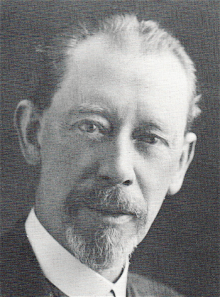
Francis William Troup was born in Huntly, Aberdeenshire, Scotland on 11 June 1859 and was articled to Campbell Douglas (1828-1910) and James Sellars (1843-1888) from 1877 to 1882. He then worked in the offices of John James Stevenson (1831-1908); John McKean Brydon (1840-1901); William Young (1834-1900); George Lethbridge (c.1847-1924); and Sir Robert Rowland Anderson (1834-1921) in Edinburgh. From 1884 to 1886 he attended the Royal Academy Schools in London, where he was awarded a Silver Medal for drawing in 1885.
Troup qualified as an architect in 1888 and commenced independent practice in London in 1891. From 1921 to 1941 he was in partnership with Harold Rooksby . He was elected an Associate of the Royal Institute of British Architects (ARIBA) in 1889, and a Fellow of the Royal Institute of British Architects (FRIBA) in 1899.
In addition to his work as an architect, Troup was a decorative designer, leadworker, and teacher of leadwork. He was an active member of the Arts & Crafts Exhibition Society and frequently and participated in their 4th (1893), 5th (1896), 6th (1899), 7th (1903), 8th (1906), 9th (1910), and 11th (1916) exhibition in London. He also exhibited at the at the Royal Academy in London from 1889 and 1903, and at the Royal Scottish Academy in Edinburgh from 1890 to 1925.
He was elected a member of the Art Workers Guild in 1895 and was Master of the Guild in 1923. He taught metalwork at the Central School of Arts and Crafts in London from 1896 to 1901. He died in London on 2 April 1941.
A biographical file on Troup is available at the Enquiry Desk, Royal Institute of British Architects Library, London
Farnley Iron Company's offices, near Leeds, 1893; " Blackfriars House. New Bridge Street, E.C., for Spicer, Ltd., 1913-20; bookbinding works, Letchworth, for W. H. Smith and Son, 1907; various other works for W. H. Smith and Son, Spottiswoode and Co., Straker and Son, Cambridge Scientific Instrument Co., etc., 1908-11; envelope factory, Union Street, S.E., for Splcer, Ltd., 1914; reconstruction of St. Luke's, Old Street, E.C., into printing works for the Bank of England, 1917-20; Gold Refinery, for the Bank of England, 1920; Hampton Criminal Lunatic Asylum, 1908-14; Hall and Shop, Tottenham Court Road, for "Whitefields", 1908; Spalding Hall, Hendon, 1902; Hall at Summertown, Oxford, 1909; Village Halls: — Ardingley,[ Ardingly] Sussex, 1902; Wootton Fitzpaine, Dorset, 1906; and Brimingham, Norfolk, 1913. Hall at 6, Queen Square, Bloomsbury, for the Art Workers' Guild, 1913; Mansfield House University Settlement, Canning Town, E., 1897-98; Memorial Almshouses, Farnley, near Leeds, 1896. Cambridge University: — Engineering Laboratories, 1920-22; and Low Temperature Research Station, 1921-22. Houseboat "Venture", for A. G. Vanderbilt, 1909. War Memorials at Devizes, Wilts; Saxlingham, Norfolk; Huntley, Aberdeenshire ; etc., etc.; and a large number of private houses in various parts of the country and in Scotland, 1900-23. [Source: Who's Who in Architecture 1923]
_____
Later works included Record Office for Bank of England, Peerless Pool Estate, Old Street, Finsbury, London, 1924; Spicers' Warehouse, Kingscote Street, City of London, 1924; Dining Club for Bank of England, Tokenhouse Yard, City of London, 1924; Finsbury Circus for Bank of England, Vity of London, 1925; King's College, The Strand, London 1925, 1928, 1931, 1933; Principal's House, and other works, Royal Caledonian Schools, Bushey, Hertfordshire 1926-41; Spicers' Warehouse, 50 Upper Thamestreet, City of London, 1927, 1929, 1931; Record Office for Bank of England, Priory Lane, Roehampton, Surrey, 1930; Sports Pavilion for King's College, London, Lavender Avenue, Mitcham, Surrey, 1932; Sports Pavilion for S.G. Minter Ltd., New Malden, Surrey, 1932; Spicers' Warehouse, Battersea, London, 1935, 1938; The Royal Albert Hall, Kensington Gore, Kensington, London, 1928-41; Temple Press, 40 Bowling Green Lane, Clerkenwell, London, 1939
_____
For detailed descriptions of these and other projects by Troup see: Jackson, Neil. F.W. Troup Architect 1859-1941. London: The Building Centre, 1985 pp. 91-116
Source of Illustrations
Directory of British Architects 1834-1914. Compiled by Antonia Brodie, et al. Volume 2: L-Z. London; New York: British Architectural Library, Royal Institute of British Architects/Continuum, 2001
Fyfe, Theodore. ‘F W Troup, FSA, FRIBA: an appreciation’. The Builder 18 April 1941 p. 382
Gray, A. Stuart. Edwardian architecture: a biographical dictionary. London: Gerald Duckworth & Co., Ltd., 1985
Jackson, Neil. F.W. Troup Architect 1859-1941. London: The Building Centre, 1985 pp. 91-116
Jackson, Neil. ‘Arts and Crafts comes to town: on the occasion of the opening of an exhibition on F W Troup, an analysis of one of his buildings revealing the way in which the Arts and Crafts principles were applied to designing on a restricted urban plot’. Architects Journal vol. 181, no. 25, 19 June 1985 pp. 28-31
7. Jackson, Neil. ‘Parsimonious philanthropy: the minor architecture of F W Troup.’ RIBA journal vol. 92, no. 6, June 1985 pp. 64-65
'Obituary'. RIBA Journal vol. 48, May 1941 p.124
'Obituary'. Architect & Building News vol. 166, 18 April 1941 p. 38
'Obituary'. Architects’ Journal vol. 93, 17 April 1941 p. 258
'Obituary'. The Builder 11 April 1941 p. 357
Troup, F. W. 'External leadwork' in The Arts Connected with Building, edited by T. Raffles Davison. London: B.T. Batsford, 1909 pp. 187-204
Troup, F. W. 'Influence of materials on design in woodwork'. in The Arts Connected with Building, edited by T. Raffles Davison. London: B.T. Batsford, 1909 pp. 63-80
Who's Who in Architecture 1923. Edited by Frederick Jackson. London: The Architectura; Press, 1923